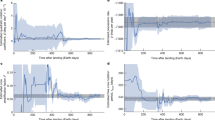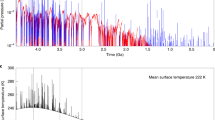Abstract
IN a recent paper (Pub. Ast. Soc. of the Pacific), Nicholson and Pettit calculate the temperature of the planet Mars, based on their radiation measures made at Mount Wilson. Most confidence is placed on measures made in the region 8 to 14μ, by the use of filter screens, and an emissivity of unity is assumed for all wave-lengths. However, Mars, being probably composed of material not unlike the earth, would radiate more like sand or quartz than like a black body, and it can be calculated from curves given by Wood (“Physical Optics”) and data given by Rosenthal (Wied. Ann. 68, p. 783), that the average ratio of the emissivity of quartz to that of a black body in the region 8 to 14μ, is 0.819. The values of the emissivity of quartz given are far below that of a black body between 8 and 10μ ; they are nearly the same from 10 to 14μ; the average ratio is taken.
This is a preview of subscription content, access via your institution
Access options
Subscribe to this journal
Receive 51 print issues and online access
$199.00 per year
only $3.90 per issue
Buy this article
- Purchase on SpringerLink
- Instant access to full article PDF
Prices may be subject to local taxes which are calculated during checkout
Similar content being viewed by others
Author information
Authors and Affiliations
Rights and permissions
About this article
Cite this article
CHASE, C. The Temperature of Mars. Nature 114, 934 (1924). https://doi.org/10.1038/114934b0
Issue date:
DOI: https://doi.org/10.1038/114934b0



